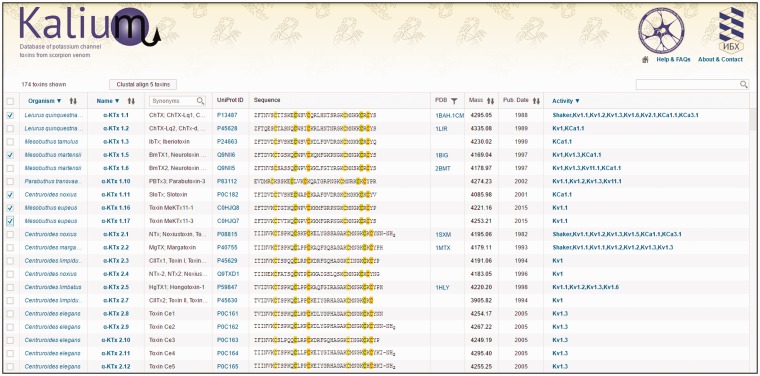Press-room / news / Science news /
Scientists at the IBCh have created a database for scorpion venom
Researchers at the Institute of Bioorganic Chemistry of the Russian Academy of Sciences (IBCh RAS) have created a database for peptide toxins from scorpion venom – Kalium. This database shall enable scientists to systematize information on the molecules that block potassium channels. In addition, such a database shall be a useful tool to conduct further studies on the channels themselves, which are today considered as pharmacological targets for certain autoimmune, oncological and neurodegenerative diseases. They published the results of their work in the magazine – Database: The Journal of Biological Databases and Curation.
– Imagine that you are studying any particular scorpion, and you need to find out what is known about the molecular diversity of the potassium channel blockers that are part of its venom. You go into the Kalium database and find all the presently known peptide molecules for this particular animal species that are acting on potassium channels. The database is well-suited for both fundamental research and practical tasks, such as when creating medicinal drugs, – explains Alexey Kuzmenkov, postgraduate at Molecular instruments for neurobiology group of the IBCh, the article’s first author.
The Kalium database is a set of information on peptide toxins extracted from scorpion venom that act on potassium channels. This constitutes half of all known peptide blockers of these channels. Once they enter the body, they selectively act on certain ion channels – membrane proteins that play a leading role in the transmission of signals in the nervous system. The disruption of the function of these proteins leads to various diseases, and therefore, they are considered important pharmacological targets.

Kalium database.
Because potassium channels are the most represented by the superfamily of ion channels, the systematization of the relevant information on the molecules acting on them is an interesting and important problem in Bioorganic Chemistry and Pharmacology.
– In the 80s, scientists knew only five to ten peptide molecules acting on a different types of targets, so there was no need for such databases, – says Alexey. – Then, they started to intensively develop transcriptomic analysis methods that allowed to use nucleotide sequences to predict the primary structure of the peptide toxins. The amount of information increased dramatically, and at some point, there was chaos in the classification, since some of the molecules with the same parameters had to be classified differently. It became unclear where the actual peptides and the hypothesized ones were, or which peptides were fully characterized, and which ones were characterized in part, etc. Our work eliminates this chaos”.
Currently, the Kalium database contains 174 toxins whose existence is confirmed at the protein level, that is, they were isolated directly from animals or were obtained through one genetic engineering process or the other. Alex and his colleagues collected information from different databases and scientific publications. Unlike UniProt protein sequence databases, Kalium contains information only about the real-life molecules. In addition, the molecular weight is calculated taking into account the closure of disulfide bonds, and this has an effect on the molecular target (specific isoforms of potassium channels). It is easy to switch over from Kalium to other databases such as NCBI Taxonomy Browser, Uniprot and the spatial structure database – PDB.
In the near future, the researchers plan to complement Kalium with peptides isolated from other animals: spiders, cones (predatory mollusks), anemones (Anthozoa), bees and snakes. Thus, Kalium covers a large group of molecules that act on ion channels: peptide potassium channel blockers.
june 20, 2016

